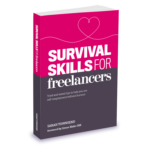How to win at social media without losing your mind

We freelancers have a love–hate relationship with social media.
On the one hand, it’s a vital source of connection, information, and even business. On the other hand, it’s a giant pain in the backside and a sinkhole that swallows up wasted hours doing god-knows-what when we should be nailing those deadlines.
What’s the secret to making social media work for you, without losing your day – and your mind?!
We all know where we’d be without our online friends: out in the cold, isolated world of working alone in our sorry little home offices, is where. Those Facebook groups, Twitter chats and timelines provide everything from office banter to “your-client-did-WHAT?!” support.
They’re life support for freelancers.
But, social media comes with a warning.
If you’re not disciplined – hell, even if you are – social media can be a dangerous distraction.
It’s also an enormous source of pressure. It sits on your devices like a digital conscience, taunting you with all the things you should have done:
- “Have you updated your LinkedIn profile recently? You know you should’ve asked that client for a recommendation by now!”
- “Why haven’t you shared something fresh and funny on Twitter this morning? What’s wrong with you?”
- “C’mon, you know there’s no point even having a Facebook page these days unless you’re prepared to advertise!”
- “Your Instagram grid is looking tired and you haven’t posted for days… surely you have something to share?!”
Social media wants a piece of you. And it wants it now.
But listen up!
Unless you have literally no work – and if that’s the case, I humbly suggest you have bigger problems than how to manage your social media presence – stop trying to do it all!
You’re not omnipotent. Or is it omnipresent? Maybe both.
The secret to social media success is to pick no more than two platforms and do them really well.
There’s nothing wrong with establishing a profile on every platform – it certainly won’t harm your Google ranking. But as long as your information is up-to-date and relevant, and you check in regularly to respond to any messages from potential clients, don’t be afraid to leave it at that.
So, which platforms should you choose?
Good question.
It makes sense to hang out where your clients are. If you’re a B2B business, LinkedIn and Twitter are likely to be the best fit, while B2C freelancers will have more luck finding their audience on Facebook, Instagram or Pinterest.
Run your social media – don’t let it run you
Once you’ve picked your platforms of choice, here are a few tips to help you get the best out of your social media marketing.
Whatever business you’re in, you should have a personal profile on LinkedIn. Think of it as a virtual CV that showcases your skills and experience. You don’t have to spend time engaging, liking and posting, but at least be present.
If you want to do LinkedIn well, start by optimising your profile. There are plenty of people out there – experts such as Jonathan Pollinger or John Espirian, for starters – who’ll happily tell you how to do it.
Once you’re set up and ready to roll, check in at least once a day:
- Like and comment on relevant posts
- Ask your clients for recommendations (I had 109 at the last count)
- Congratulate people on their new jobs
- Create your own thought-provoking posts
- Share long-form articles
…and remember to keep your profile up to date.
INSTAGRAM AND PINTEREST
Great social media content doesn’t require expensive gear. Once you know your audience and you’ve got to grips with the basics, get busy with your smartphone camera and start creating engaging posts that reflect your personal brand.
Free tools like Snapseed and Afterlight are great for editing your pics, while apps such as Canva and Spark Post help you combine text and images for eye-catching posts.
Experiment to find the hashtags and posts that work for your audience, and take inspiration from businesses that do Instagram and Pinterest well (but no outright copying – remember, your brand should be unique to you).
Twitter gets a bad rap; commonly from people who use it to advertise, then slate it for being a waste of time. Go figure!
If they dialled down the desperate, and started engaging, informing, and entertaining they’d have a very different experience.
So, be real. Build relationships. Show your personality. Share tips, tricks and advice. Reply to questions. And be nice!
If you carefully curate who you follow (god knows there are some hate-filled people out there, and no one needs that) Twitter can be a great source of inspiration and support.
I remain unconvinced about Facebook pages as a tool for service businesses, but if you’re in the business of selling cupcakes, jewellery, or some other photo-friendly product, it can work really well.
Keep your page up to date, and aim to post daily. Funnies and thought-provoking questions traditionally get good engagement, though it’s getting harder to achieve without paying to advertise (and that’s a whole other blog post).
If you combine this advice with the discipline to check in on social just a couple of times a day, you’ll soon notice the difference it makes to your productivity and wellbeing.
This article was first published on Digital Drum.
Grow in confidence and show self-employment who’s boss!
With 20 years of experience + advice from 100 freelancers, Survival Skills for Freelancers is your secret weapon to get more enjoyment from self-employment.
Get your copy in paperback, Kindle or Audible – and stay in touch for monthly freelance tips and advice.

